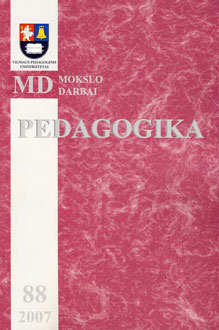Jaunesniojo mokyklinio amžiaus vaikų, gyvenančių globos įstaigose, savtvertės ir mokyklinio nerimo ypatumai
Self-esteem and School Anxiety of Primary School Children Living in Foster Homes
Author(s): Margarita Pileckaitė-Markovienė, Tomas LazdauskasSubject(s): Education
Published by: Vytauto Didžiojo Universitetas
Keywords: children living in foster homes; self-esteem; school anxiety
Summary/Abstract: In this article results of schientific investigations of psychological peculiarities of children who are bereft of parents care and live in foster homes are analysed. During last decennaries the number of children who are bereft of parents care was constantly growing in lithuania so this problem seems to be sore and actual. Miscellanious analysis of this phenomenon let to deeper understanding of problems importance, reasons and consequences, possible ways of problem solving. In this article results of scientific investigations of self-esteem and school anxiety of children living in foster homes. The aim of this investigation was to analyze peculiarities of self-esteem and school anxiety of primary school children living in foster homes. 100 primary school children living in foster homes and 100 children living with parents took part in the survey. Age range of participants was from 8 till 11 years, mean age 9,8. Semantic differential type scale made by m. Pileckaitė-markovienė (2001) for measuring of self-esteem of primary school children and test anxiety scale for children [1] were used for evaluation. results showed that children living in foster homes had lower self-esteem than children living with parents (t (165,150) = -2,952, p = 0,004). Children from foster homes felt less happy (t (142) = -4,68, p = 0,0001) and lively (t (153) = -7,046, p = 0,0001). Especially low self-esteem had girls living in foster homes (t (80) = -2,956, p = 0,004). It was found that children living in foster homes experienced more anxiety in school in comparison with children living with parents (t (190) = 5,27, p = 0,0001). They experienced more anxiety during tests (t (19 8) = 4,561, p = 0,0001), had more somatic complains (t (184,073) = 4,994, p = 0,0001), were more concerned because of school (t (193,378) = 2,813, p = 0,005) than children who lived with parents. These results confirm previous data that children living in foster homes need special attention of teachers and psychologists because of their low self-esteem and high anxiety.
Journal: Pedagogika
- Issue Year: 2007
- Issue No: 88
- Page Range: 124-130
- Page Count: 7
- Language: Lithuanian

